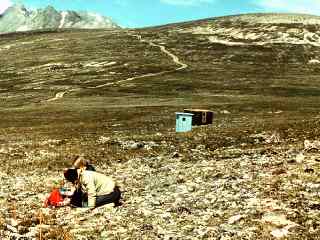|
The Alpine TundraThe tundra biome is found at high elevations in mountainous terrain, as well. Many, if not all, the same features of the arctic tundra are found in the alpine tundra. Microclimate is an important control over the distribution of plant species as slope and exposure control the availability of light and moisture. The landscape is dotted with small cushion plants, lichens and mosses. Willows are found where moisture is abundant. Other factors like soil development, movement of soil by animals, and drainage determine vegetation community distribution.
Vegetation consists of low growing shrubs, cushion plants, small forbs exploding with colorful flowers and lush meadows of sedges and grasses. These plants cover gentle slopes and rock crevices. Rock surfaces are dotted with a cover of lichens and mosses. Most species are slow-growing perennials. Plants have been forced to adapt to such an extreme environment. Plant roots store nutrients and energy during poor growing periods. Roots make up ninety percent of some plants in the alpine tundra. Flowers often are large on tundra plants. Other parts of the plant are small to save energy and reducing exposure to wind. Some plants have waxy coatings or hairs thus losing minimal heat and water to the wind. The location of plant communities is correlated with the duration of snow cover. While snow is blown free from exposed sites, it accumulates in the lee of obstructions and in depressions. Community location is also related to soil, drainage, and movement of soil by burrowing animals, and frost action throughout much of the alpine tundra. Dense willow thickets often occupy moist depressions on the lee side of ridges. A deep cover of snow during the winter protects buds from the wind and freezing temperatures. These are the tallest perennials growing above the krummholz of the ecotone. Figure 13.31 Alpine tundra fell field (foreground) and on a rocky knoll (upper right) Colorado, USA. (Courtesy UNESCO) Fell fields are colorful rock gardens exposed to the rigors of the wind. Wind removes snow throughout the season subjecting the plants to desiccation. Low-lying mats and cushion plants nestle against the rocky surface.
Figure 13.32 The alpine tundra of Niwot Ridge in early May (Photo credit: Michael Ritter) The climate of the tundra is exceedingly harsh. Annual precipitation is around 40 inches, but effective precipitation is far below that amount. Snow remains as permanent snow fields at some sites. Wind speeds can exceed 100 mph and mean annual temperature is below freezing. Diurnal temperature ranges are small because the air is mixed by the constant winds. The frost free season is approximately 1 1/2 months.

Soils are quite variable in the tundra. Thin soils lie in the valleys scoured by glaciers. Mature residual soils are found on unglaciated ridges and between rocks brought to the surface by frost heave to form polygons. Soil ice is found in all soils in winter, and soil temperatures are low enough to form patches of permafrost.
Figure 13.33 Solifluction terraces with snow lying behind. (Photo credit: Michael Ritter)
Solifluction terraces are a common landscape feature of the alpine tundra. Solifluction terraces with willow growing on top and to the back are visible in the center of the Figure 13.33. Late lying snow patches keep conditions moist to permit willow growth. Reaching a few feet high, willows are covered in snow to protect the over-wintering buds. Willows are the tallest of any species in the alpine tundra.
The plant communities mentioned above are considered climax communities mainly because they change so slowly. Communities are often disturbed by small burrowing animals like the pocket gopher that churn up the soil and eat plant roots, or voles which can devastate above - ground biomass. Recovery after disturbance proceeds exceedingly slow, slower than any other mountain ecosystem.
|
 Figure 13.30 tundra vegetation (Photo credit: Michael Ritter)
Figure 13.30 tundra vegetation (Photo credit: Michael Ritter)

 Figure
13.34 A polygon, the periglacial feature outlined
in black, was caused by frost heave. (Photo
credit: Michael Ritter)
Figure
13.34 A polygon, the periglacial feature outlined
in black, was caused by frost heave. (Photo
credit: Michael Ritter)